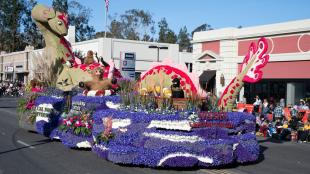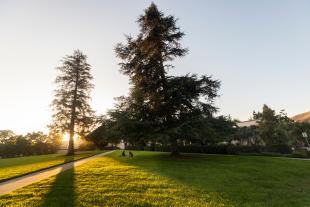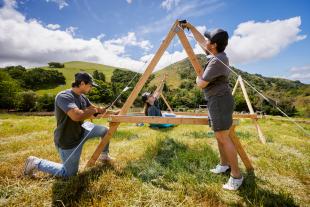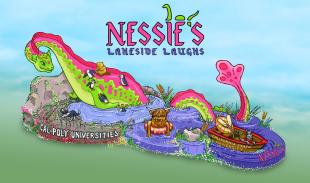Reimagine Paradise: Cal Poly Architecture Students Design Future of Devastated Northern California Town

Three months after the Camp Fire destroyed much of the Northern California town of Paradise, Cal Poly students are working on plans intended to give its thousands of displaced residents hope for the future.
Thirty-six third-year architecture students are coordinating with peers from two other universities to reimagine how Paradise can rebuild after the devasting fire killed 86 people and burned more than 13,900 homes in November.
Two architecture design studios, taught by Cal Poly faculty members Stacey White and Kent Macdonald, are developing a design concept plan for a complete community of 30,000 people — from roads and circulation to determining where residential, commercial, public and other uses could be located. Paradise residents will have a chance to vote on the various options to determine which of them is developed into the final concept.
At the end of the two-quarter course in June, fire survivors and others leading Paradise’s recovery effort will be able to view a virtual-reality walkthrough of their town, rebuilt and reimagined, White said. 
“If I can go back to Paradise High School and give one of those students hope that this is a town they could go back to, that would be enough for me,” said architecture student Sophia Smith, from Salt Lake City, who is focused on redesigning bike paths and other ways to make the town more pedestrian-friendly.
The students are also sharing their ideas with architecture students from Montana State University, who are designing a residential development for 100 families; and Chico State’s College of Engineering, Computer Science and Construction Management, whose students and faculty are researching numerous topics such as water quality and environmental issues, and the failure of the town’s emergency notification system.
“We are happy that our college could provide a venue and facilitate interaction with our campus and Chico community for the work the Cal Poly team is doing to benefit the recovery in Paradise,” said Melody Stapleton, dean for Chico State’s College of Engineering, Computer Science, and Construction Management. “Chico State prides itself on seamlessly integrating with the North State community, and we’re pleased to have our faculty experts and students play a small role in the future of Paradise.”
Cal Poly students traveled to Paradise in January to meet with the communities of Chico and Paradise, Chico State faculty and students, Paradise High School teachers and students, and members of the Camp Fire Long Term Recovery Working Group, which is focused on the area’s future. Cal Poly received financial support from San Francisco-based WRNS Studio for the costs associated with travel, supplies and materials necessary for community-engagement including this preliminary site visit.
“It’s so heartwarming, seeing that there are people out there who want to get involved and use their particular tools to help,” said Charles Brooks, a 14-year Paradise resident who lost his home and has started a foundation, Rebuild Paradise, to assist with job creation and provide long-term support to businesses and residents in disaster-affected Butte County. 
Students in Macdonald’s class are also participating in a collegewide competition to help design a new sign for the town entrance in collaboration with Brooks’ foundation and a committee of community members.
“Cal Poly students are in Central California and they want to help and give vision to our community — it’s unbelievable,” Brooks said.
The students will return to Butte County Feb. 21-22 to present updates to Paradise residents, to the Long Term Recovery Working Group, and to Chico State faculty and students. They’ll visit again in April and then present their final design concepts to the community in June.
“Projects like these that are rooted in resilient design thinking represent the best of what Cal Poly can do: giving students the chance to learn while they develop solutions to real and meaningful social, economic and environmental problems while also providing a community service,” said Margot McDonald, head of Cal Poly’s Architecture Department.
The students are working as a class or in groups to come up with an overall plan and zoning map for the town. In addition, each student has selected a building that they believe addresses a critical community need. Each student has been paired with a professional firm that offers mentoring and peer-review of the design solutions.
In January, the students capped their trip to Butte County with a visit to the town of Paradise.“It was a very sobering experience,” said architecture student Foster Westover of Menlo Park, California. “Everything was black, and then you’d see a chimney or a child’s bedframe. The experience of seeing that up close — it was eye-opening.”
Westover is working on identifying spots around the redesigned town to locate small commercial areas near residential areas, so that future residents don’t have to travel too far for their needs.
To attract new, younger residents to Paradise, the students envision more mixed-use housing and opportunities for new businesses and industries to set up shop in what has traditionally been a bedroom or retirement community.
“The key to all of this is variety,” said Ryan Huddlestun of San Jose, who imagines an industry centered on outdoor recreation and is designing a green hotel and conference center. “We want to provide options for employment for people who don’t want to commute to Chico.”
Both Macdonald’s and White’s studio classes have planned a centralized downtown to create a sense of identity and a gathering space for the town’s festivals and events.
Student Katherine Young of Clermont, Florida, is designing a new town hall and courthouse that would centralize Paradise’s services and include an outdoor plaza.
“I’m so thankful to be working on this,” she said. “This is one of those one-in-a-lifetime projects.”




